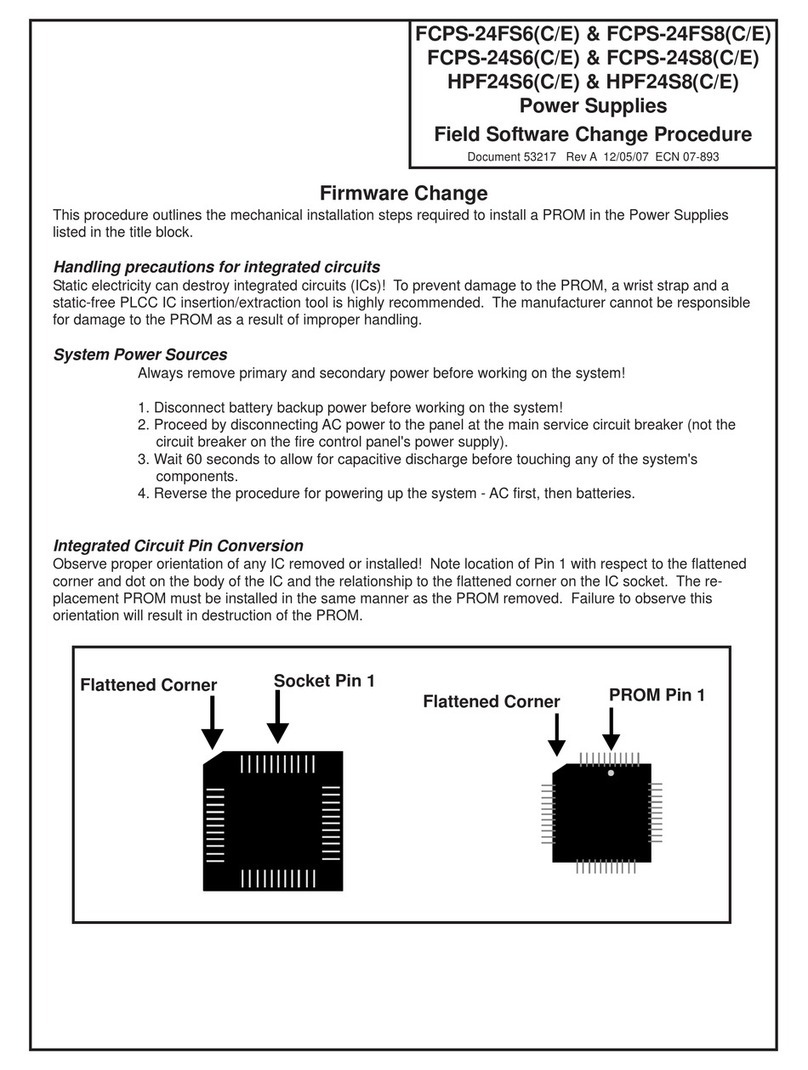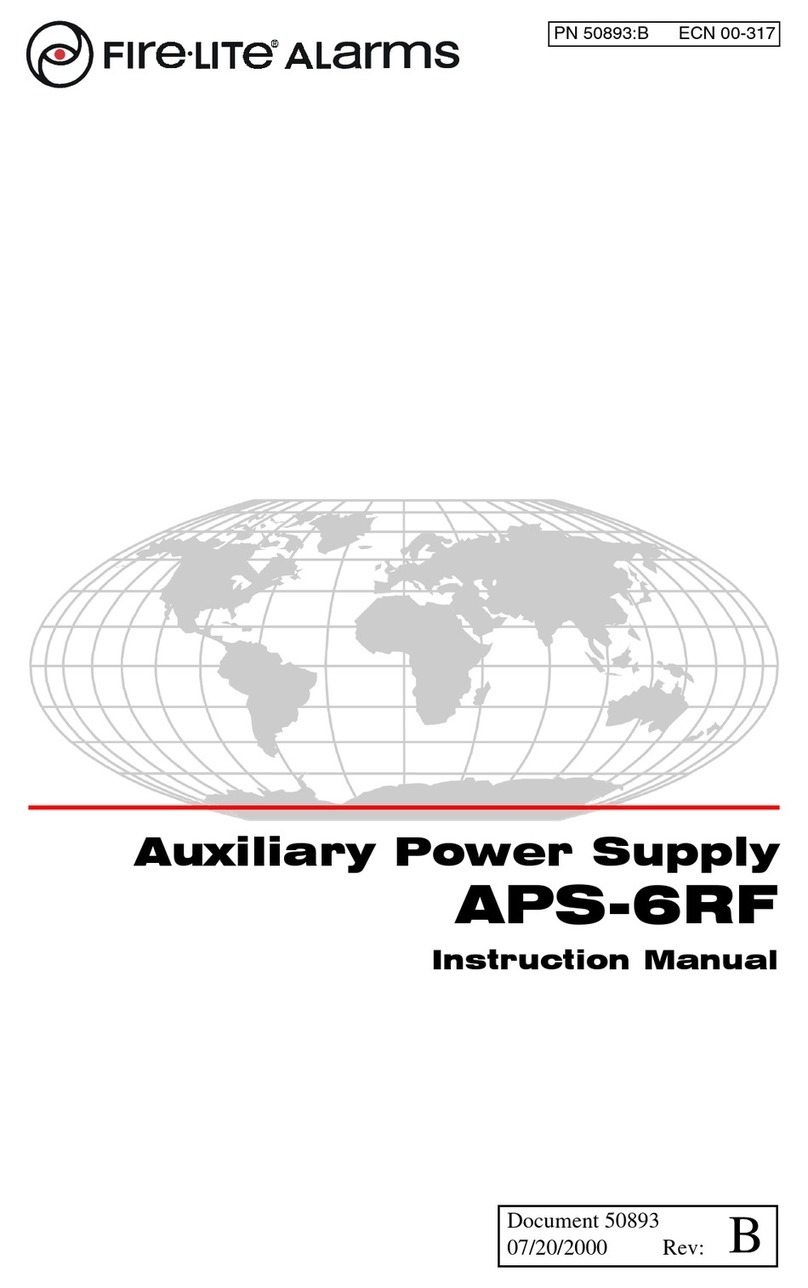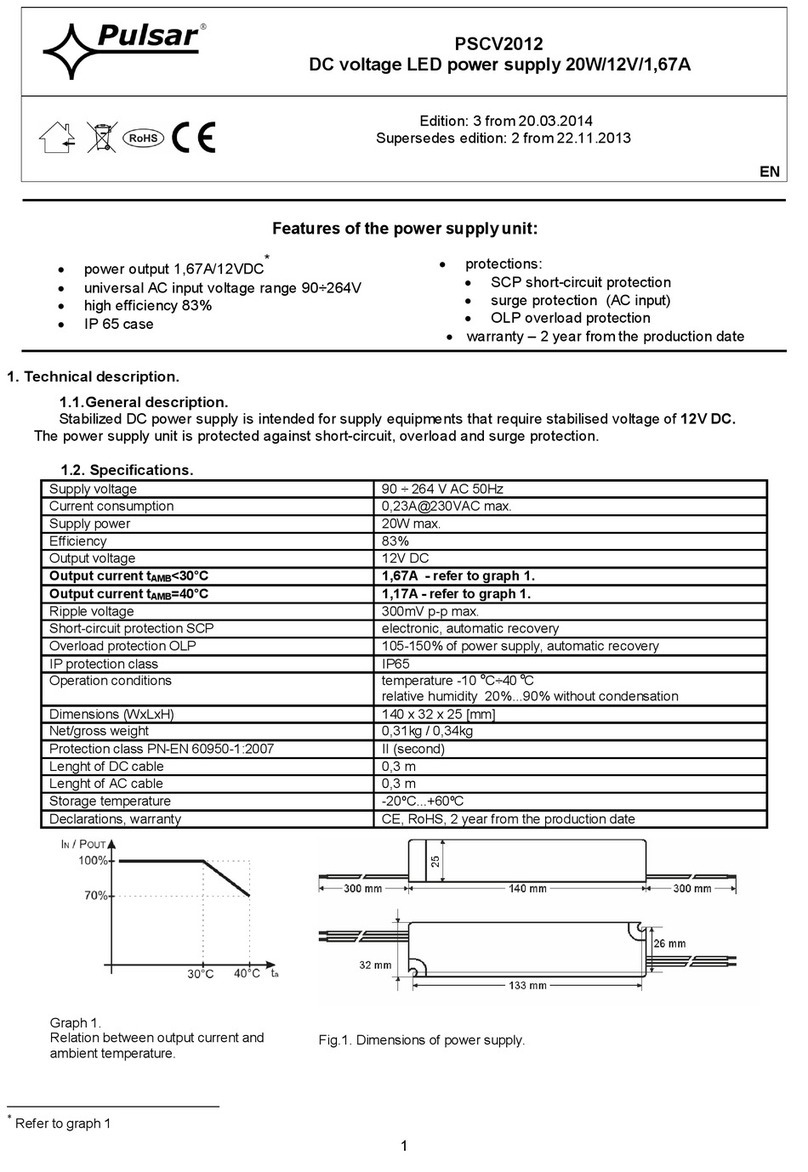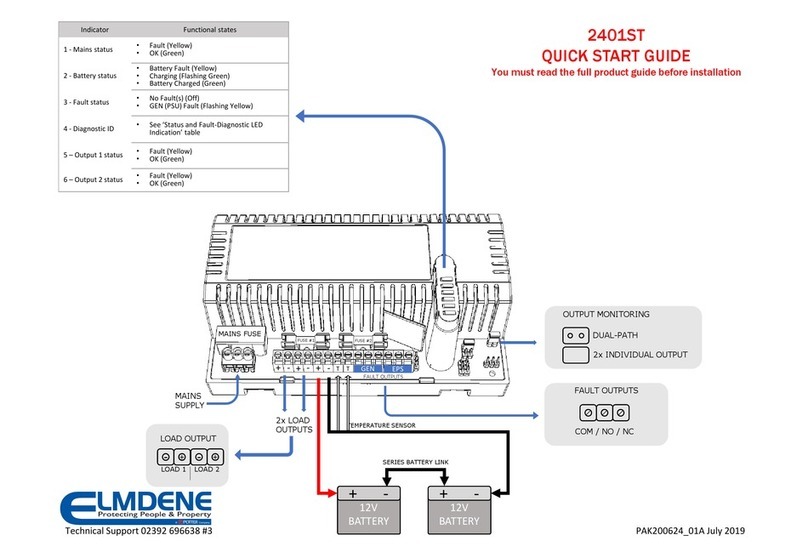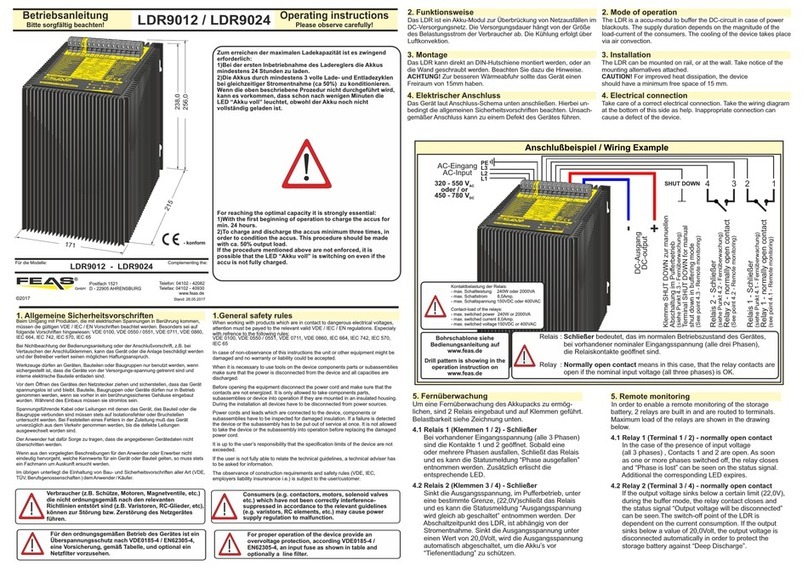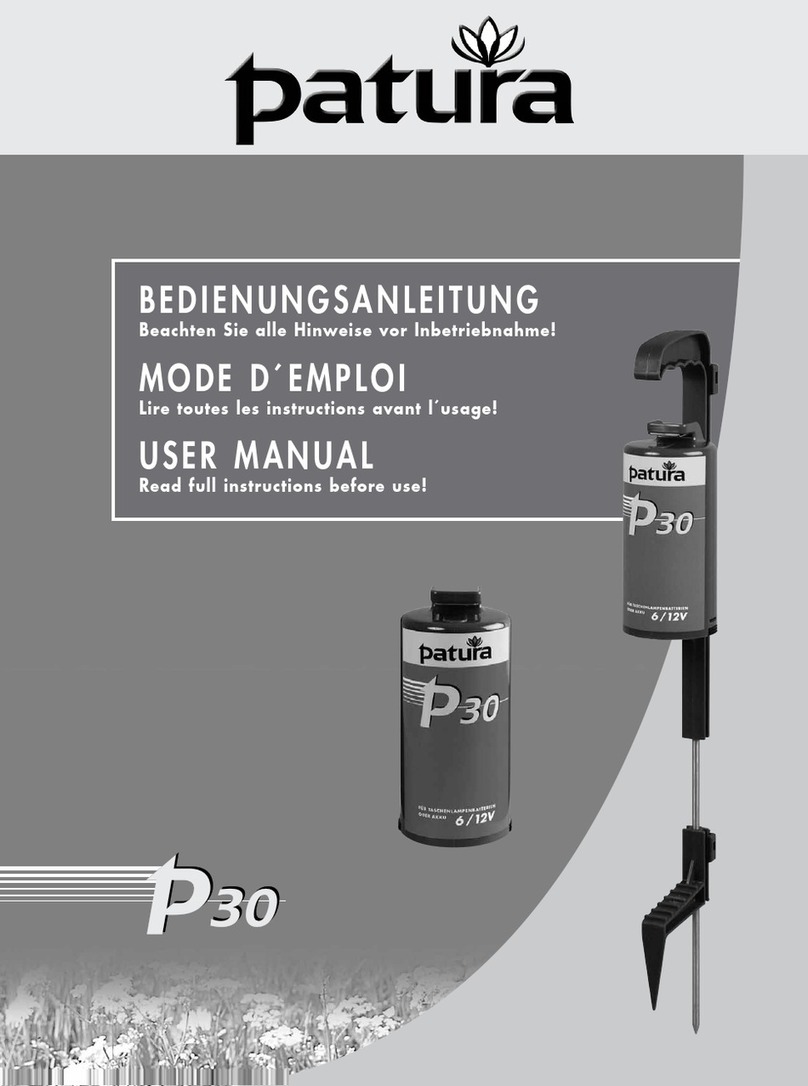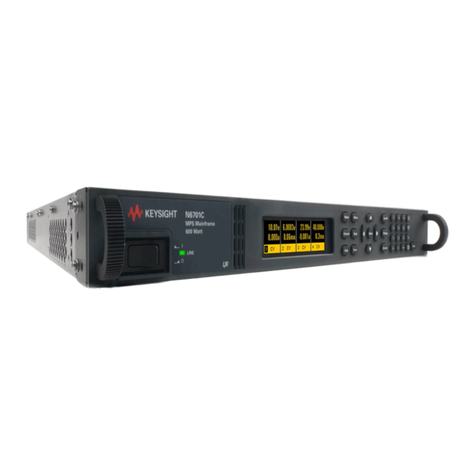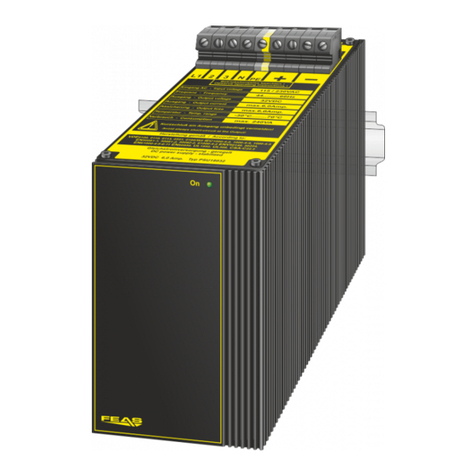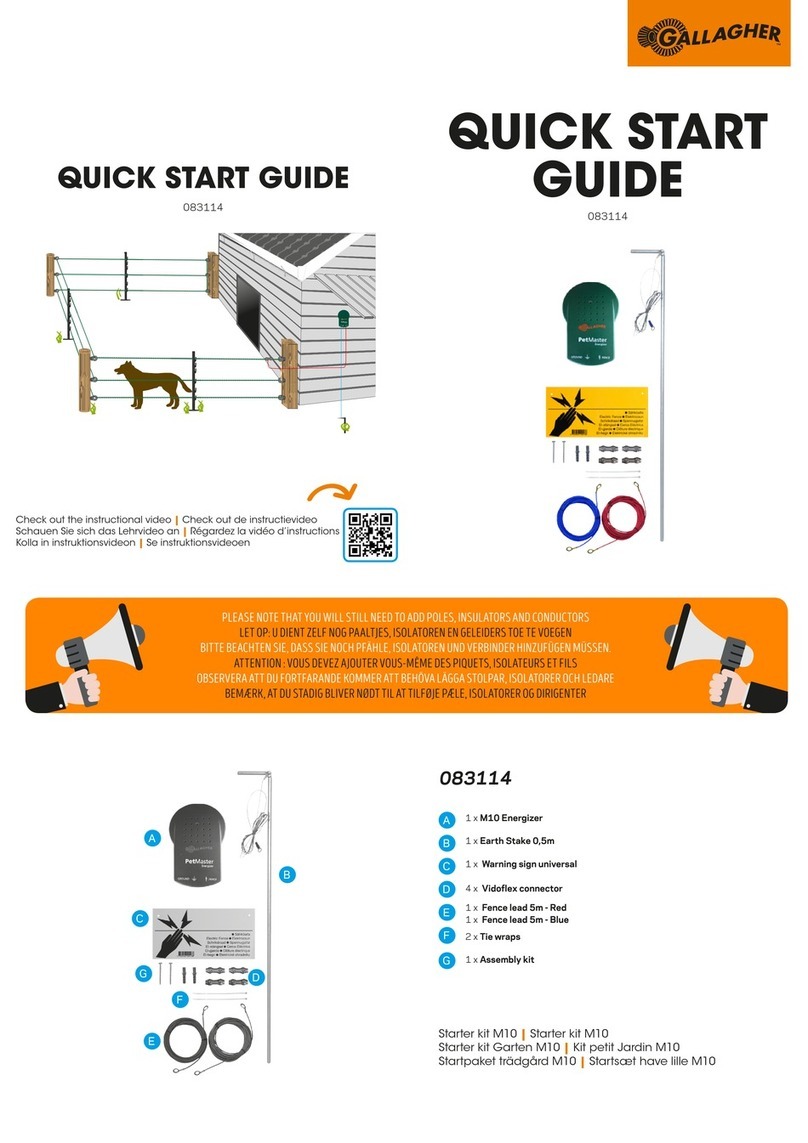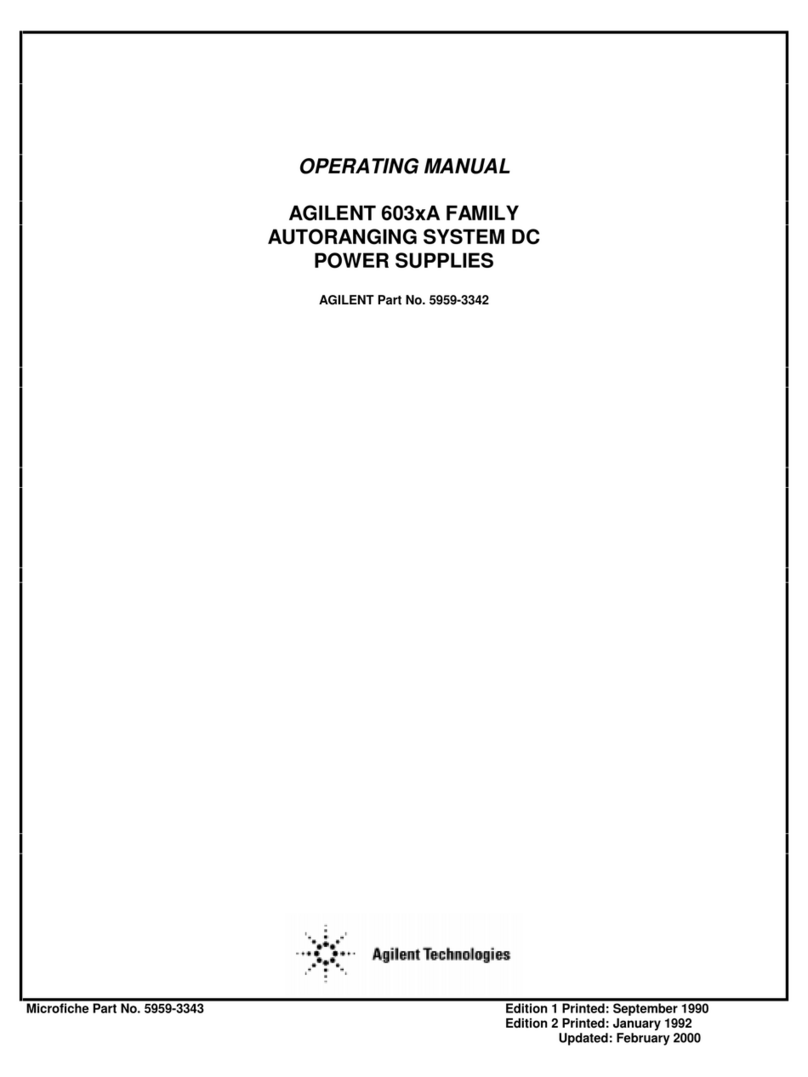Fire-Lite FCPS-24FS8 User manual

Field Charger/Power Supply
FCPS-24FS6
FCPS-24FS8
PN: 51883:B ECN 02-609
Document #51883
12/04/02 Revision: B

LimWarLg.p65 01/10/2000
An automatic fire alarm system–typically made up of smoke
detectors, heat detectors, manual pull stations, audible warn-
ing devices, and a fire alarm control with remote notification
capability–can provide early warning of a developing fire.
Such a system, however, does not assure protection against
property damage or loss of life resulting from a fire.
The Manufacturer recommends that smoke and/or heat detec-
tors be located throughout a protected premise following the
recommendations of the current edition of the National Fire
Protection Association Standard 72 (NFPA 72),
manufacturer's recommendations, State and local codes, and
the recommendations contained in the Guide for Proper Use
of System Smoke Detectors, which is made available at no
charge to all installing dealers. A study by the Federal Emer-
gency Management Agency (an agency of the United States
government) indicated that smoke detectors may not go off in
as many as 35% of all fires. While fire alarm systems are de-
signed to provide early warning against fire, they do not guar-
antee warning or protection against fire. A fire alarm system
may not provide timely or adequate warning, or simply may not
function, for a variety of reasons:
Smoke detectors may not sense fire where smoke cannot
reach the detectors such as in chimneys, in or behind walls, on
roofs, or on the other side of closed doors. Smoke detectors
also may not sense a fire on another level or floor of a build-
ing. A second-floor detector, for example, may not sense a
first-floor or basement fire.
Particles of combustion or "smoke" from a developing fire
may not reach the sensing chambers of smoke detectors be-
cause:
• Barriers such as closed or partially closed doors, walls, or
chimneys may inhibit particle or smoke flow.
• Smoke particles may become "cold," stratify, and not reach
the ceiling or upper walls where detectors are located.
• Smoke particles may be blown away from detectors by air
outlets.
•Smoke particles may be drawn into air returns before
reaching the detector.
The amount of "smoke" present may be insufficient to alarm
smoke detectors. Smoke detectors are designed to alarm at
various levels of smoke density. If such density levels are not
created by a developing fire at the location of detectors, the
detectors will not go into alarm.
Smoke detectors, even when working properly, have sensing
limitations. Detectors that have photoelectronic sensing
chambers tend to detect smoldering fires better than flaming
fires, which have little visible smoke. Detectors that have ion-
izing-type sensing chambers tend to detect fast-flaming fires
better than smoldering fires. Because fires develop in differ-
ent ways and are often unpredictable in their growth, neither
type of detector is necessarily best and a given type of detec-
tor may not provide adequate warning of a fire.
Smoke detectors cannot be expected to provide adequate
warning of fires caused by arson, children playing with
matches (especially in bedrooms), smoking in bed, and violent
explosions (caused by escaping gas, improper storage of
flammable materials, etc.).
Heat detectors do not sense particles of combustion and
alarm only when heat on their sensors increases at a prede-
termined rate or reaches a predetermined level. Rate-of-rise
heat detectors may be subject to reduced sensitivity over time.
For this reason, the rate-of-rise feature of each detector
should be tested at least once per year by a qualified fire pro-
tection specialist.
Heat detectors are designed to protect
property, not life.
IMPORTANT!
Smoke detectors must be installed in the
same room as the control panel and in rooms used by the sys-
tem for the connection of alarm transmission wiring, communi-
cations, signaling, and/or power.
If detectors are not so lo-
cated, a developing fire may damage the alarm system, crip-
pling its ability to report a fire.
Audible warning devices such as bells may not alert people
if these devices are located on the other side of closed or
partly open doors or are located on another floor of a building.
Any warning device may fail to alert people with a disability or
those who have recently consumed drugs, alcohol or medica-
tion. Please note that:
•Strobes can, under certain circumstances, cause seizures
in people with conditions such as epilepsy.
•Studies have shown that certain people, even when they
hear a fire alarm signal, do not respond or comprehend the
meaning of the signal. It is the property owner's responsibil-
ity to conduct fire drills and other training exercise to make
people aware of fire alarm signals and instruct them on the
proper reaction to alarm signals.
•In rare instances, the sounding of a warning device can
cause temporary or permanent hearing loss.
A fire alarm system will not operate without any electrical
power. If AC power fails, the system will operate from standby
batteries only for a specified time and only if the batteries
have been properly maintained and replaced regularly.
Equipment used in the system may not be technically com-
patible with the control. It is essential to use only equipment
listed for service with your control panel.
Telephone lines needed to transmit alarm signals from a
premise to a central monitoring station may be out of service
or temporarily disabled. For added protection against tele-
phone line failure, backup radio transmission systems are rec-
ommended.
The most common cause of fire alarm malfunction is inade-
quate maintenance. To keep the entire fire alarm system in
excellent working order, ongoing maintenance is required per
the manufacturer's recommendations, and UL and NFPA stan-
dards. At a minimum, the requirements of Chapter 7 of NFPA
72 shall be followed. Environments with large amounts of
dust, dirt or high air velocity require more frequent mainte-
nance. A maintenance agreement should be arranged
through the local manufacturer's representative. Maintenance
should be scheduled monthly or as required by National and/
or local fire codes and should be performed by authorized pro-
fessional fire alarm installers only. Adequate written records
of all inspections should be kept.
While a fire alarm system may lower insurance
rates, it is not a substitute for fire insurance!
Fire Alarm System Limitations

LimWarLg.p65 01/10/2000
WARNING -
Several different sources of power can be con-
nected to the fire alarm control panel.
Disconnect all sources
of power before servicing. Control unit and associated equip-
ment may be damaged by removing and/or inserting cards,
modules, or interconnecting cables while the unit is energized.
Do not attempt to install, service, or operate this unit until this
manual is read and understood.
CAUTION -
System Reacceptance Test after Software
Changes.
To ensure proper system operation, this product
must be tested in accordance with NFPA 72 Chapter 7 after
any programming operation or change in site-specific soft-
ware. Reacceptance testing is required after any change, ad-
dition or deletion of system components, or after any modifica-
tion, repair or adjustment to system hardware or wiring.
All components, circuits, system operations, or software func-
tions known to be affected by a change must be 100% tested.
In addition, to ensure that other operations are not inadvert-
ently affected, at least 10% of initiating devices that are not
directly affected by the change, up to a maximum of 50 de-
vices, must also be tested and proper system operation veri-
fied.
This system meets NFPA requirements for operation at
0-49°C/32-120°F and at a relative humidity of 85% RH (non-
condensing) at 30°C/86°F. However, the useful life of the
system's standby batteries and the electronic components
may be adversely affected by extreme temperature ranges
and humidity. Therefore, it is recommended that this system
and all peripherals be installed in an environment with a nomi-
nal room temperature of 15-27°C/60-80°F.
Verify that wire sizes are adequate for all initiating and
indicating device loops. Most devices cannot tolerate more
than a 10% I.R. drop from the specified device voltage.
Like all solid state electronic devices, this system may
operate erratically or can be damaged when subjected to light-
ning-induced transients. Although no system is completely
immune from lightning transients and interferences, proper
grounding will reduce susceptibility.
Overhead or outside
aerial wiring is not recommended, due to an increased sus-
ceptibility to nearby lightning strikes.
Consult with the Techni-
cal Services Department if any problems are anticipated or
encountered.
Disconnect AC power and batteries prior to removing or in-
serting circuit boards. Failure to do so can damage circuits.
Remove all electronic assemblies prior to any drilling, filing,
reaming, or punching of the enclosure. When possible, make
all cable entries from the sides or rear. Before making modifi-
cations, verify that they will not interfere with battery, trans-
former, and printed circuit board location.
Do not tighten screw terminals more than 9 in-lbs.
Over-tightening may damage threads, resulting in reduced
terminal contact pressure and difficulty with screw terminal
removal.
Though designed to last many years, system components
can fail at any time. This system contains static-sensitive
components. Always ground yourself with a proper wrist strap
before handling any circuits so that static charges are re-
moved from the body. Use static-suppressive packaging
to protect electronic assemblies removed from the unit.
Follow the instructions in the installation, operating, and
programming manuals. These instructions must be followed
to avoid damage to the control panel and associated
equipment. FACP operation and reliability depend upon
proper installation by authorized personnel.
Adherence to the following will aid in problem-free
installation with long-term reliability:
WARNING: This equipment generates, uses, and can
radiate radio frequency energy and if not installed and
used in accordance with the instruction manual, may
cause interference to radio communications. It has
been tested and found to comply with the limits for class
A computing device pursuant to Subpart B of Part 15 of
FCC Rules, which is designed to provide reasonable
protection against such interference when operated in a
commercial environment. Operation of this equipment in
a residential area is likely to cause interference, in which
case the user will be required to correct the interference
at his own expense.
Canadian Requirements
This digital apparatus does not exceed the Class A
limits for radiation noise emissions from digital
apparatus set out in the Radio Interference Regulations
of the Canadian Department of Communications.
Le present appareil numerique n'emet pas de bruits
radioelectriques depassant les limites applicables aux
appareils numeriques de la classe A prescrites dans le
Reglement sur le brouillage radioelectrique edicte par le
ministere des Communications du Canada.
FCC Warning
Installation Precautions

4FCPS-24FS PN 51883:B 12/04/02
Notes

FCPS-24FS P/N: 51883:B 12/04/02 5
SECTION 1: System Overview .............................................................................................................................8
1.1: General ........................................................................................................................................................8
1.2: Features .......................................................................................................................................................8
1.3: Start-up Procedure.......................................................................................................................................9
1.4: Jumpers........................................................................................................................................................10
1.4.1: Jumper JP1 - Ground Fault Detection...............................................................................................10
1.4.2: Jumpers JP2 and JP3:
Coded/Noncoded Input Selection ......................................................................................................10
1.5: LED Indicators ............................................................................................................................................10
1.6: Specifications ..............................................................................................................................................11
1.7: General ........................................................................................................................................................13
SECTION 2: Installation .......................................................................................................................................14
2.1: Backbox Mounting......................................................................................................................................14
2.2: NAC Circuit Wiring ....................................................................................................................................16
2.2.1: Style Y (Class B)...............................................................................................................................16
2.2.2: ZNAC-4 Class A Option Module .....................................................................................................16
2.3: Addressable Module Mounting...................................................................................................................17
2.4: NEC Power-limited Wiring Requirements..................................................................................................18
SECTION 3: Programming Options ....................................................................................................................19
3.1: DIP Switch Settings ....................................................................................................................................20
3.2: Programmable Features Description ...........................................................................................................21
3.2.1: Synchronization Type Selection........................................................................................................21
3.2.2: Synchronization Mode - Master/Slave..............................................................................................21
3.2.3: AC Fail Delay ...................................................................................................................................21
3.2.4: Input/Output Function.......................................................................................................................22
3.2.4.1 Auxiliary Power Control .........................................................................................................22
3.2.5: Charger Enable/Disable ....................................................................................................................23
3.2.6: Door Closers .....................................................................................................................................23
SECTION 4: Trouble Supervision ........................................................................................................................24
4.1: Supervision via FACP Notification Appliance Circuit ...............................................................................24
4.1.1: Supervision of FACP to FCPS wiring...............................................................................................24
4.1.2: Supervision of FCPS-24FS Faults ....................................................................................................24
4.1.3: Trouble Relay....................................................................................................................................25
4.2: AC Loss Reporting Delay ...........................................................................................................................25
SECTION 5: Applications .....................................................................................................................................26
5.1: Controlling Four NACs With One Input and Selective Silence..................................................................26
5.2: Controlling Three NACs and One Door Holder With One Input ...............................................................28
5.3: Split Temporal Mode of Operation .............................................................................................................30
5.4: Remote Supply With Resettable and Nonresettable Power ........................................................................32
5.5: Door Release Service For All Four Outputs ...............................................................................................34
5.6: Multiple Synchronized FCPS-24FS Power Supplies ..................................................................................35
5.7: Multiple Cascaded & Synchronized FCPS-24FS Power Supplies..............................................................36
SECTION 6: Power Supply Requirements ..........................................................................................................37
6.1: Overview .....................................................................................................................................................37
6.2: Calculating the AC Branch Circuit .............................................................................................................37
6.3: Calculating the System Current Draw.........................................................................................................38
6.3.1: Overview...........................................................................................................................................38
6.3.2: How to Calculate System Current Draw...........................................................................................38
6.4: Calculating the Battery Size........................................................................................................................40
6.4.1: NFPA Battery Requirements.............................................................................................................40
6.4.2: Selecting and Locating Batteries.......................................................................................................40
Table of Contents

6FCPS-24FS PN 51883:B 12/04/02
Notes

FCPS-24FS PN 51883:B 12/04/02 7
It is imperative that the installer understand the requirements of the Authority Having Jurisdiction
(AHJ) and be familiar with the standards set forth by the following regulatory agencies:
• Underwriters Laboratories Standards
• NFPA 72 National Fire Alarm Code
NFPA Standards
NFPA 72 National Fire Alarm Code
NFPA 70 National Electrical Code
Underwriters Laboratories Documents:
UL 464 Audible Signaling Appliances
UL 864 Standard for Control Units for Fire Protective Signaling Systems
UL 1638 Visual Signaling Appliances
UL 1971 Signaling Devices for Hearing Impaired
Other:
NEC Article 250 Grounding
NEC Article 300 Wiring Methods
NEC Article 760 Fire Protective Signaling Systems
Applicable Local and State Building Codes
Requirements of the Local Authority Having Jurisdiction (LAHJ)
Other Fire•Lite Documents:
Device Compatibility Document Document #15384
Before proceeding, the installer should be familiar with the following documents.

System Overview General
8FCPS-24FS PN 51883:B 12/04/02
SECTION 1 System Overview
The FCPS-24FS6 is a 6 amp power supply and the FCPS-24FS8 is an 8 amp power
supply. Each FCPS-24FS power supply is a compact, cost-effective, remote power
supply and battery charger which provides ADA compatible strobe synchronization.
The remote power supplies consist of a filtered 24 VDC output that can be configured
to drive four Style Y (Class B) NACs (Notification Appliance Circuits). The four
circuits can be configured for Style Z (Class A) with the optional ZNAC-4 Class A
converter module. Alternatively, the four output circuits may be configured as 24 VDC
resettable or nonresettable power outputs. The input circuits, which control the power
supply operation, are triggered by the reverse polarity of an NAC or by a 12 VDC or 24
VDC power source. The power supplies are compatible with 12 VDC and 24 VDC
control panels.
1.1 General
The FCPS-24FS power supplies can be used as remotely mounted power supplies and
battery chargers to power four noncoded or coded NACs. The Main FACP (Fire Alarm
Control Panel) NAC(s) is connected to the remote power supply input circuit(s). When
the control input circuit activates due to reverse polarity of the NAC from the FACP, the
power supply will activate its Notification Appliance Circuits.
During the inactive or nonalarm state, the power supply supervises its NAC field wiring
for short and open conditions. AC fail, battery, charger and ground fault troubles will
also be monitored by the power supply. If an NAC or power supply fault is detected,
the power supply Normally-Closed Trouble contact will open.
If an alarm condition occurs and the NAC is activated, the supervision is disabled and
the Notification Appliance Circuit is no longer supervised. Supervision of other power
supply faults such as low battery, AC loss, ground fault and battery charger trouble will
continue and may be monitored via the Trouble relay contacts.
1.2 Features
• Self-contained in a lockable cabinet
• 24 VDC remote power supply
• Outputs are completely power-limited
• Two optically-isolated input/control circuits, compatible with 12 VDC and 24
VDC control panel NACs
• Four output circuits:
✓Fully filtered power
✓Four 24 VDC Style Y (Class B) NACs
✓Optional ZNAC-4 Class A converter module for conversion to Style Z NACs
✓Alternatively, all four circuits may be configured as 24 VDC power outputs
✓Output circuits may be configured as resettable or nonresettable
• NAC Trouble LED - blinks to indicate the number of the circuit in trouble
• Maximum current available for any one output circuit: 3.0 amps
• Maximum total continuous current available:
✓4.0 amps for FCPS-24FS6
✓6.0 amps for FCPS-24FS8

Start-up Procedure System Overview
FCPS-24FS PN 51883:B 12/04/02 9
• Maximum total short term current (one hour maximum):
✓6.0 amps for FCPS-24FS6
✓8.0 amps for FCPS-24FS8
• Integral supervised battery charger for lead acid batteries only
• Capable of charging 7.0 AH to 18.0 AH (Amp Hour) batteries
• Fully supervised power supply, battery and NACs
• Selectable Strobe Synchronization for NACs (System Sensor, Gentex and
Wheelock)
• Coded signal synchronization
• Fixed terminal blocks for field wiring capable of accepting 12 - 22 AWG wire
• Selectable Ground Fault detection by jumper JP1
• Power supply trouble Form-C relay contacts (fail-safe)
• Optional delay of AC loss reporting for 8 hours
• Auxiliary Power Output for SLC modules (500 mA maximum) with optional
reset for 4-wire smoke detectors
• Mounting location for optional addressable control module
1.3 Start-up Procedure
1. Configure the power supply jumpers as described in "Jumpers" on page 10
2. Install the power supply as described in "Installation" on page 14
3. Program the power supply as described in "Programming Options" on page 19
4. Wire the power supply circuits, referring to the options described in "Trouble
Supervision" on page 24 and the application examples in "Applications" on page
26
5. Connect primary power source wiring while observing the following:
✓Make certain that the AC mains circuit breaker is off before making any
wiring connections between the mains and the power supply
✓Make certain primary power source is 120 VAC, 60 Hz, 3.2 amps
✓Run a pair of wires (with ground conductor) from the protected premises main
breaker box to TB1 of the power supply main circuit board
✓Use 14 AWG (1.6 mm O.D.) or heavier gauge wire with 600V insulation
6. Apply power to the power supply using the following procedure:
✓connect a properly charged battery to connector JP4 on the power supply main
circuit board
✓apply AC power by turning on the AC mains circuit breaker connected to the
power supply

System Overview Jumpers
10 FCPS-24FS PN 51883:B 12/04/02
1.4 Jumpers
CAUTION! Remove all power (AC & DC) before cutting or moving any jumpers.
1.4.1 Jumper JP1 - Ground Fault Detection
Jumper JP1 is located in the top right section of the power supply circuit board. Cutting
JP1 will disable ground fault detection by the power supply. This should only be done
if ground faults are being monitored by a panel connected to the FCPS power supply.
1.4.2 Jumpers JP2 and JP3:
Coded/Noncoded Input Selection
Jumpers JP2 and JP3 are located in the top right section of the power supply circuit
board. JP2 is used for Control Input Circuit #1 and JP3 is used for Control Input Circuit
#2. The position of these jumpers will depend on the type of signal being fed to the
input circuits:
• If the source voltage to the input circuit is a noncoded (steady voltage) input
signal, the jumper for the corresponding input circuit should be in the default
position which jumpers the bottom two pins (as illustrated in drawing at left).
• If the source voltage to the input circuit is coded (variable voltage), the jumper
for the corresponding input circuit should be moved to jumper the top two pins.
1.5 LED Indicators
• AC Power on (green) LED - indicates AC power is present
• Ground Fault (yellow) LED - indicates a ground fault condition
• Battery Trouble (yellow) LED - indicates low or no battery
• NAC Trouble (yellow) LED - indicates a Notification Appliance Circuit trouble
(blinks once for Circuit 1 trouble, twice for Circuit 2 trouble, three times for
Circuit 3 trouble and four times for Circuit 4 trouble. Note that multiple circuits
in trouble will cause the LED to blink the number of the circuit with the highest
number)
• ChargerTrouble/AC Loss (yellow) LED - indicates a charger fault or loss of AC
power
Jumper positions shown
for noncoded (steady)
source voltage
JP3 JP2
jumpers
24s8jp3b.cdr

Specifications System Overview
FCPS-24FS PN 51883:B 12/04/02 11
1.6 Specifications
Refer to Figure 1.1 on page 12 for terminal locations.
Primary AC Power - TB1
• 120 VAC, 60 Hz, 3.2 amps maximum
• Wire size: minimum #14 AWG with 600V insulation
Control Input Circuits - TB4, Terminals 3 (+) & 4 (-) and 7 (+) & 8 (-)
• Trigger Input Voltage: 9 to 32 VDC
• Input Current Draw in Alarm Polarity:
✓16 to 32 volts, 2.0 mA maximum per input
✓9 to 16 volts, 1.0 mA maximum per input
NAC/Output Circuits - TB2, Terminals 1 (+) & 2 (-), 3 (+) & 4 (-), 5 (+) & 6 (-) and
7 (+) & 8 (-) alarm polarity
• Voltage Rating: 24 VDC filtered
• Current:
✓Maximum for any one circuit - 3.0 amps
✓Maximum total continuous current for all output:
FCPS-24FS6 - 4.0 amps
FCPS-24FS8 - 6.0 amps
✓Maximum total short term current (one hour maximum) for all outputs:
FCPS-24FS6 - 6.0 amps
FCPS-24FS8 - 8.0 amps
• Output Circuit Types:
✓Four Style Y NACs (require 4.7 KΩ End-of-Line Resistors) or
Style Z NACs using the optional ZNAC-4 Class A converter module
OR
✓Four resettable or nonresettable 24 VDC power outputs
• Refer to Fire•Lite Device Compatibility Document for listed compatible devices
Trouble Relay Contact Rating - TB5
• Fail-safe Form-C relay (normally energized, transfers with loss of power)
• 5.0 amps @ 24 VDC or 5.0 amps @ 30 VAC
Secondary Power (battery) Charging Circuit - JP4
• Supports lead acid type batteries only
• Float Charge Voltage: 27.6 VDC
• Maximum Charge Current: 1.5 A
• Battery fuse (F1) 15A, 30V
• Maximum Battery Capacity: 18.0 AH
• Power supply draws maximum standby current of 65 mA from batteries
Auxiliary Power Output - TB4 Terminals 9 (+) & 10 (-)
• Specific application power
• Voltage Rating: 24 VDC
• Current:
✓170 mA maximum with internal 7.0 Amp Hour batteries
✓500 mA maximum with external 18.0 Amp Hour batteries

System Overview Specifications
12 FCPS-24FS PN 51883:B 12/04/02
1 2 3 4 5 6 7 8
ON
TB1
J2
TRANSFORMER 2 TRANSFORMER 1
J1
F1
JP4
30V
15A
SW1 TB4
JP3
J3
TB5
TB2
JP1
JP2
+ -
EARTH NEUT HOT
OUT4
- NAC4 +
OUT3
- NAC3 +
OUT2
- NAC2 +
OUT1
- NAC1 +
8 7 6 5 4 3 2 1
3 2 1
10
9
8
7
6
5
4
3
2
1
AUX -
IN2-
IN2+
OUT1-
OUT1+
IN1-
IN1+
SYNC IN -
SYNC IN +
AUX +
NO NC
AUX TBL
COM
BATTERY
AC BATT AC/
CHGR
GND
FLT NAC
TRBL
Figure 1.1 FCPS-24FS Board Layout
- Aux. Common
+ Aux. 24 VDC*
- Control Input 2
+ Control Input 2
- Out Common
+ Out/Trouble Contact
- Control Input 1
+ Control Input 1
- Sync Input
+ Sync Input
NAC/Out 1 +
NAC/Out 1 -
NAC/Out 2 +
NAC/Out 2 -
NAC/Out 3 +
NAC/Out 3 -
NAC/Out 4 +
NAC/Out 4 -
Supervised
Earth
AC Neutral
AC Hot
Trouble Relay
Form-C Fail-safe
(shown energized)
Normally Open
Normally Closed
Common
JP1 Ground Fault
Detection
(cut to disable)
JP2 & JP3
Coded/Noncoded
Input Selection
JP4 Supervised
- Battery
+ Battery
18 AH, 24 VDC
Nonpower-
limited
LEDs
Charger Trouble/AC Loss (yellow)
NAC Trouble (yellow)
Battery Trouble (yellow)
Ground Fault (yellow)
AC Power (green)
SW1
Programming
DIP Switches
F1
Battery Fuse
15A, 30V
Nonpower-limited
To Transformer #1
To Transformer #2
Auxiliary Output
500 mA Specific
Application Power
J3
ZNAC-4 Connector
*Note: Auxiliary Power
Output is power-limited
but not supervised
Power-limited,
Supervised in NAC Mode with Jumpers JP5,
JP6, JP7 & JP8 in positions shown below
24fs8brd.cdr

General System Overview
FCPS-24FS PN 51883:B 12/04/02 13
1.7 General
The FCPS may be used in a number of different applications. It may be used as a
remotely-mounted power supply and battery charger where it can provide up to four
coded or noncoded, synchronized or nonsynchronized NACs (Notification Appliance
Circuits). Alternatively, output #4 can be used as a door holder circuit which will
provide a steady 24 VDC output until an alarm condition or AC fail condition causes it
to drop to 0 VDC following a 60 second delay. All four outputs can also provide power.
One possible application for the FCPS remote power supply utilizes the NAC repeater
feature. In this application, one or two NACs are connected from the main FACP to the
remote power supply control input circuits. When the control input circuits are
activated by the reverse polarity of the NACs, the power supply will activate its
corresponding output circuits as programmed by SW1 DIP switch configuration (refer
to Table 3.1 on page 20).
During the inactive state, the remote power supply supervises its NAC field wiring for
short and open conditions. If a fault is detected, the power supply will enter a trouble
condition and illuminate the NAC Trouble LED. When the NACs are activated, the
supervision is disabled and the circuits are no longer supervised. Supervision of other
power supply faults such as low battery, battery charger trouble, ground fault and AC
loss will continue and may be monitored via the power supply trouble relay.
If an application requires that all four outputs activate at the same time, only one NAC
is required from the FACP. For this application, the NAC is connected to control input
circuit #1 and SW1 DIP switch is set for this operation.
Style Y NAC
or Door
Holder Power
Output #4
AC Power
Figure 1.2 Simplified FCPS Block Diagram
Battery Charger
Style Y NAC
Output #3
Style Y NAC
Output #2
Style Y NAC
Output #1
Note: All NAC
outputs can be
converted to Style Z
with ZNAC-4 option
module
FCPS Trouble
Contact Output
24 VDC Specific
Application Power
NAC Control
Input #2
(from FACP)
NAC Control
Input #1
(from FACP)
Sync. Input
Input/Output Functions are Programmable
by SW1 DIP Switch Settings
24fsblok.cdr

Installation Backbox Mounting
14 FCPS-24FS PN 51883:B 12/04/02
SECTION 2 Installation
Carefully unpack the system and check for shipping damage. Select a location for the
cabinet that is in a clean, dry, vibration-free area where extreme temperatures are not
encountered. The area should be readily accessible with sufficient room to easily install
and maintain the power supply. Locate the top of the cabinet approximately five feet
above the floor with the hinge mounting on the left. Determine the number of
conductors required for the devices to be installed and determine the appropriate
knockouts. All wiring must be in accordance with the National and/or Local codes for
fire alarm systems and power supplies.
2.1 Backbox Mounting
The circuit board contains static-sensitive components. Always ground yourself with a
proper wrist strap before handling any boards so that static charges are removed from
the body. Use static suppressive packaging to protect electronic assemblies.
1. Remove the PC board and transformers from the backbox before installing
backbox. Set the board and transformers aside in a safe, clean place. Avoid static
discharge which may damage static sensitive components on the board
2. Mark and predrill holes for the top two keyhole mounting bolts
3. Install two upper fasteners in the wall with the screw heads protruding
approximately ¼”
4. Using the upper keyholes, mount the backbox over the two screws
5. Mark the lower two holes, remove the backbox from the wall and drill the
mounting holes
6. Mount the backbox, install the remaining fasteners and tighten all screws
7. When the location is dry and free of construction dust, reinstall the PC board and
transformers and continue with the installation
8. IMPORTANT! Make certain to connect the supplied grounding strap between
the Earth terminal on TB1 (AC Terminal Block) of the main circuit board and the
chassis ground stud as illustrated in Figure 2.1:
!
TB1
J2
TRANSFORMER 2 TRANSFORMER 1
J1
JP3
J3
TB5
TB2
JP1
JP2
EARTH
NEUT HOT
OUT4
- NAC4 +
OUT3
- NAC3 +
OUT2
- NAC2 +
OUT1
- NAC1 +
AUX -
IN2-
AUX +
NO NC
AUX TBL
COM
CAUTION
HIGH VOLTAGE
CAUTION
HIGH VOLTAGE
NAC 4 CLA SS A
A- A+
NAC 3 CLA SS A
A- A+
NAC 2 CLA SS A
A- A+
NAC 1 CLA SS A
A- A+
Figure 2.1 Grounding Strap
Ground Stud
Grounding Strap
Earth Terminal on TB1 (AC Terminal Block)
Backbox
Mounting Plate
24fsgrnd.cdr

Backbox Mounting Installation
FCPS-24FS PN 51883:B 12/04/02 15
Figure 2.2 Backbox Mounting Dimensions
Bottom
Height=15.00”
(38.10 cm)
10.625”
(26.99 cm)
0.75”
(1.9 cm)
2.875” (7.3 cm)
Backbox = 14.5”
(36.8 cm)
Depth = 3.050”
(7.75 cm)
Top
9.1” (23.1 cm)
2.7”
(6.86cm)
1.125” (2.868 cm)
Mounting Plate Pem Studs
Backbox Mounting Holes
rcpscabb.cdr
Ground Stud

Installation NAC Circuit Wiring
16 FCPS-24FS PN 51883:B 12/04/02
2.2 NAC Circuit Wiring
2.2.1 Style Y (Class B)
The standard configuration for NACs is Style Y (Class B) as shown in Figure 2.3.
2.2.2 ZNAC-4 Class A Option Module
The ZNAC-4 is an optional Class A conversion module which mounts to connector J3
on the upper right side of the FCPS-24FS circuit board. This module allows the FCPS-
24FS6 or FCPS-24FS8 to support Style Z (Class A) Notification Appliance Circuits.
TB4
JP3
J3
TB5
TB2
JP1
JP2
OUT4
-NAC4+
OUT3
-NAC3+
OUT2
-NAC2+
OUT1
-NAC1+
AUX -
IN2-
IN2+
OUT1-
OUT1+
IN1-
IN1+
SYNC IN -
SYNC IN +
AUX +
NO NC
AUX TBL
COM
1 2 3 4 5 6 7 8 9 10
8
7
6
5
4
3
2
1
TB2
3
2
1
+
-
+
-
+
-
+
-
Figure 2.3 NAC Style Y (Class B)
4.7KΩELR
Horn Strobe
Horn Strobe
Horn Strobe
Alarm Polarity Shown
FCPS-24FS Circuit Board
24fsclsb.cdr
TB4
JP3
J3
TB5
TB2
JP1
JP2
OUT 4
-NAC4+
OUT 3
-NAC3+
OUT2
-NAC2+
OUT1
-NAC1+
AUX -
IN2-
IN2+
OUT1-
OUT1+
IN1-
IN1+
SYNC IN -
SYNC IN +
AUX +
NO NC
AUX TBL
COM
1 2 3 4 5 6 7 8 9 10
8
7
6
5
4
3
2
1
3
2
1
OUT4
-NAC4+
8
7
TB2
+
+
-
-
+
-
+
-
+
-
Figure 2.4 Style Z (Class A) NACs using ZNAC-4 Option Module
ZNAC-4 Option Module
J3
Horn Strobes
ZNAC-4
Alarm Polarity
Shown
FCPS-24FS Circuit
24fsclsa.cdr

Addressable Module Mounting Installation
FCPS-24FS PN 51883:B 12/04/02 17
2.3 Addressable Module Mounting
The FCPS-24FS has been designed to allow the mounting of an addressable control,
relay or monitor module on the main circuit board inside the power supply cabinet with
the module status LED visible through the closed door. This allows power to be fed
from the FCPS-24FS Auxiliary Power output directly to the module, if needed, without
running the power wires outside the cabinet. As an example, Figure 2.5 illustrates
wiring from the Auxiliary power output terminals to a CMF-300 control module’s
terminals 3 (-) and 4 (+).
Note that the optional module mounting kit (P/N 90286) is required to install an
addressable module on the power supply main circuit board. The kit includes four
female/female and four male/female standoffs as well as four mounting screws.
1 2 3 4 5 6 7 8
ON
1 2 3 4 5 6 7 8
ON
TB1
J2
TRANSFORMER 2 TRANSFORMER 1
J1
F1
JP4
30V
15A
SW1
SW1
TB4
TB4
JP3
JP3
J3
TB5
TB2
JP1
JP2
JP2
+ -
EARTH N EUT HOT
OUT4
- NAC4 +
OUT3
- NAC3 +
OUT2
- NAC2 +
OUT1
- NAC1 +
AUX -
AUX -
IN2-
IN2-
IN2+
IN2+
OUT1-
OUT1-
OUT1+
OUT1+
IN1-
IN1-
IN1+
IN1+
SYNC IN -
SYNC IN -
SYNC IN +
SYNC IN +
AUX +
AUX +
NO NC
AUX TBL
COM
BATTERY
AC BATT
GND
FLT NAC
TRBL AC/
CHGR
CAUTION
HIGH VOLTAGE
CAUTION
HIGH VOLTAGE
NAC 4 CLA SS A
A- A+
NAC 3 CLA SS A
A- A+
NAC 2 CLA SS A
A- A+
NAC 1 CLA SS A
A- A+
8
9
8
8
9
9
10
11
12
13
14
150
0
1
1
2
2
3
3
4
4
5
5
6
6
7
7
0
1
2
3
4
7
6
5
TENS
ONES
ADDRESS
LOOP
Figure 2.5 Mounting Module In FCPS-24FS Cabinet
standoff
standoff standoff
standoff
24fsmodl.cdr
Module Installation
1. Remove FCPS-24FS main circuit board from
mounting plate by removing four corner screws.
2. Install four male/female standoffs through bottom
of board in holes indicated in illustration above.
3. Screw four female/female standoffs to male ends of
standoffs installed in Step 2 to secure in place.
4. Place addressable module over standoffs installed
in Step 3 and secure with supplied screws.
5. Reinstall main circuit board on mounting plate and
wire module as show in illustration above.
female/female standoffs
female/female standoffs
addressable module
mounting screw

Installation NEC Power-limited Wiring Requirements
18 FCPS-24FS PN 51883:B 12/04/02
2.4 NEC Power-limited Wiring Requirements
Power-limited and nonpower-limited circuit wiring must remain separated in the
cabinet. All power-limited circuit wiring must remain at least 0.25” away from any
nonpower-limited circuit wiring. Furthermore, all power-limited circuit wiring and
nonpower-limited circuit wiring must enter and exit the cabinet through different
conduits. One such example of this is shown below. Your specific application may
require different conduit knockouts to be used. Any conduit knockouts may be used.
For power-limited applications, use of conduit is optional.
1 2 3 4 5 6 7 8
ON
TB1
J2
TRANSFORMER 2 TRANSFORMER 1
J1
F1
JP4
30V
15A
SW1 TB4
JP3
J3
TB5
TB2
JP1
JP2
+ -
EARTH NEUT H OT
OUT4
- NAC4 +
OUT3
- NAC3 +
OUT2
- NAC2 +
OUT1
- NAC1 +
AUX -
IN2-
IN2+
OUT1-
OUT1+
IN1-
IN1+
SYNC IN -
SYNC IN +
AUX +
NO NC
AUX TBL
COM
BATTERY
AC AC/
BATT CHGR
GND
FLT NAC
TRBL
CAUTION
HIGH VOLTAGE
CAUTION
HIGH VOLTAGE
NAC 4 CLASS A
A- A+
NAC 3 CLASS A
A- A+
NAC 2 CLASS A
A- A+
NAC 1 CLASS A
A- A+
SYNC IN -
SYNC IN +
8
9
8
8
9
9
10
11
12
13
14
150
0
1
1
2
2
3
3
4
4
5
5
6
6
7
7
0
1
2
3
4
7
6
5
TENS
ONES
ADDRESS
LOOP
Figure 2.6 Power-limited Wiring Example
AC Power
Nonpower-limited
Output Circuits
Power-limited Circuits
Relay Contacts
Nonpower-limited Circuit
Input Circuits
Power-limited Circuit
Specific Application
Power & SLC are
Power-limited Circuits
24fspwrl.cdr

NEC Power-limited Wiring Requirements Programming Options
FCPS-24FS PN 51883:B 12/04/02 19
SECTION 3 Programming Options
This section describes the programming options available via DIP switch settings. The
FCPS can be field programmed using option DIP switch SW1 which is located in the
lower center of the circuit board. Refer to the following illustration for switch location
and DIP switch placement in the ON and OFF positions.
ON
1 2 3 4 5 6 7 8
1 2 3 4 5 6 7 8
ON
TB1
J2
TRANSFORMER 2 TRANSFORMER 1
J1
F1
JP4
30V
15A
SW1 TB4
JP3
J3
TB5
TB2
JP1
JP2
+ -
EARTH NEU T HOT
OUT4
- NAC4 +
OUT3
- NAC3 +
OUT2
- NAC2 +
OUT1
- NAC1 +
8 7 6 5 4 3 2 1
3 2 1
10
9
8
7
6
5
4
3
2
1
AUX -
IN2-
IN2+
OUT1-
OUT1+
IN1-
IN1+
SYNC IN -
SYNC IN +
AUX +
NO NC
AUX TBL
COM
BATTERY
AC AC/
BATT CHGR
GND
FLT
NAC
TRBL
Switches 1 through 7 shown
in OFF (Open) position
Switch 8 shown in ON
(Closed) position
Figure 3.1 Field Programming DIP Switches
24fsswitc.cdr

Programming Options DIP Switch Settings
20 FCPS-24FS PN 51883:B 12/04/02
3.1 DIP Switch Settings
The following table lists the FCPS programmable features and the switch settings
required to select a particular feature. A detailed description of each feature is
presented in the following pages.
Table 3.1 DIP Switch Settings
SW1 DIP Switch ON OFF
1This switch works in conjunction with switch 2 to determine the Strobe Synchronization Type1.
21 OFF, 2 OFF = no sync (steady +24V)
1 OFF, 2 ON = System Sensor
1 ON, 2 OFF = Gentex
1 ON, 2 ON = Wheelock
3 FCPS configured for Slave Synchronization FCPS configured for Master Synchronization
4 Delay AC Fail Reporting for 8 Hours No Delay in AC Fail Reporting
5 This switch works in conjunction with switch 6 to determine Input to Output functions
65 OFF, 6 OFF = General Alarm
• FCPS configured as Master (switch 3 OFF), NAC Outputs 1 through 42are controlled by Control
Input #1; Sync Input is ignored.
• FCPS configured as Slave (switch 3 ON), NAC Outputs 1 through 42are controlled by Control
Input #1; Sync Input is monitored3.
• Resettable or nonresettable Auxiliary Power Output is available from TB4 Terminals 9 & 10. Control
Input #2 determines if reset will occur (must go from On to Off for a 6 second reset to occur).
• Output #4 function follows DIP switch 8 setting.
5 OFF, 6 ON = Split Alarm
• FCPS configured as Master (switch 3 OFF), NAC Outputs 1 & 2 are controlled by Control Input #1
and Outputs 3 & 42are controlled by Control Input #2; Sync Input is ignored.
• FCPS configured as Slave (switch 3 ON), NAC Outputs 1 & 2 are controlled by Control Input #1
and Outputs 3 & 42are controlled by Control Input #2; Sync Input is monitored3.
• Only nonresettable Auxiliary Power is available from TB4 Terminals 9 & 10.
• Output #4 function follows DIP switch 8 setting.
5 ON, 6 OFF = Split Temporal
• FCPS configured as Master (switch 3 OFF), Control Input #1 controls NAC Outputs 1 & 2
and Control Input #2 controls Outputs 3 & 42which will generate a Temporal code signal without
sync; Sync Input is ignored.
• FCPS configured as Slave (switch 3 ON), Control Input #1 controls NAC Outputs 1 & 2 and Control
Input #2 controls Outputs 3 & 42 which will generate a Temporal code signal without sync; Sync
Input is monitored for Outputs 1 & 23.
• Only nonresettable Auxiliary Power is available from TB4 Terminals 9 & 10.
• Output #4 function follows DIP switch 8 setting.
5 ON, 6 ON = Selective Silence
• FCPS configured as Master (switch 3 OFF), NAC Outputs 1 through 42are controlled by Control
Input #1; Sync Input is ignored.
• FCPS configured as Slave (switch 3 ON), NAC Outputs 1 through 42are controlled by Control
Input #1; Sync Input is monitored3.
• Control Input #2 determines when Selective Silence for all outputs will occur4
• Only nonresettable Auxiliary Power is available from TB4 Terminals 9 & 10.
• Output #4 function follows DIP switch 8 setting.
7 Disable Charger Enable Charger
8 Output Circuit #4 = Door Holder Output Circuit #4 = NAC
1Strobe Synchronization only works with non-coded NACs.
2 If Door Closer function is selected (switch 8 ON), Output 4 does not function as an NAC, therefore sync input is ignored for it.
3 If no synchronization is selected by switches 1 & 2, the Sync Input is ignored.
4 Selective Silence allows the silencing of the sounder portion of a horn/strobe combination device without turning off the strobe.
This manual suits for next models
1
Table of contents
Other Fire-Lite Power Supply manuals
Popular Power Supply manuals by other brands
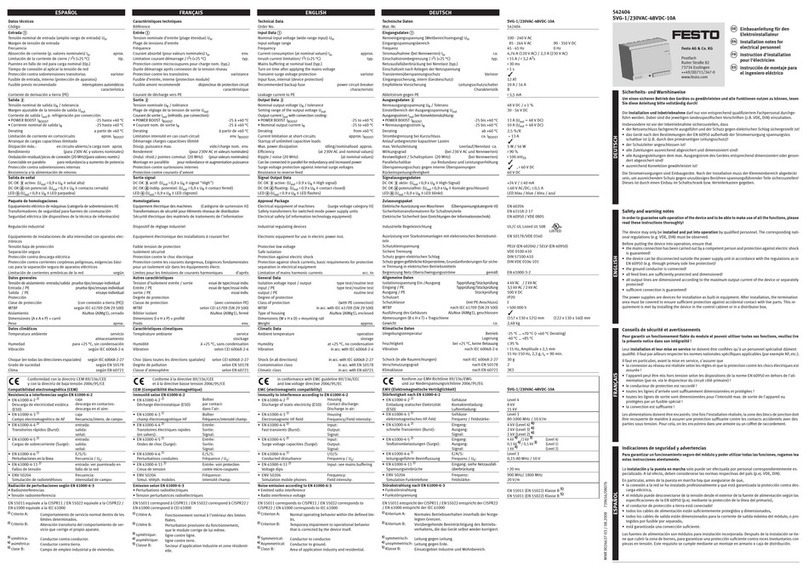
Festo
Festo SVG-1/230VAC-48VDC-10A Installation notes for electrical personnel
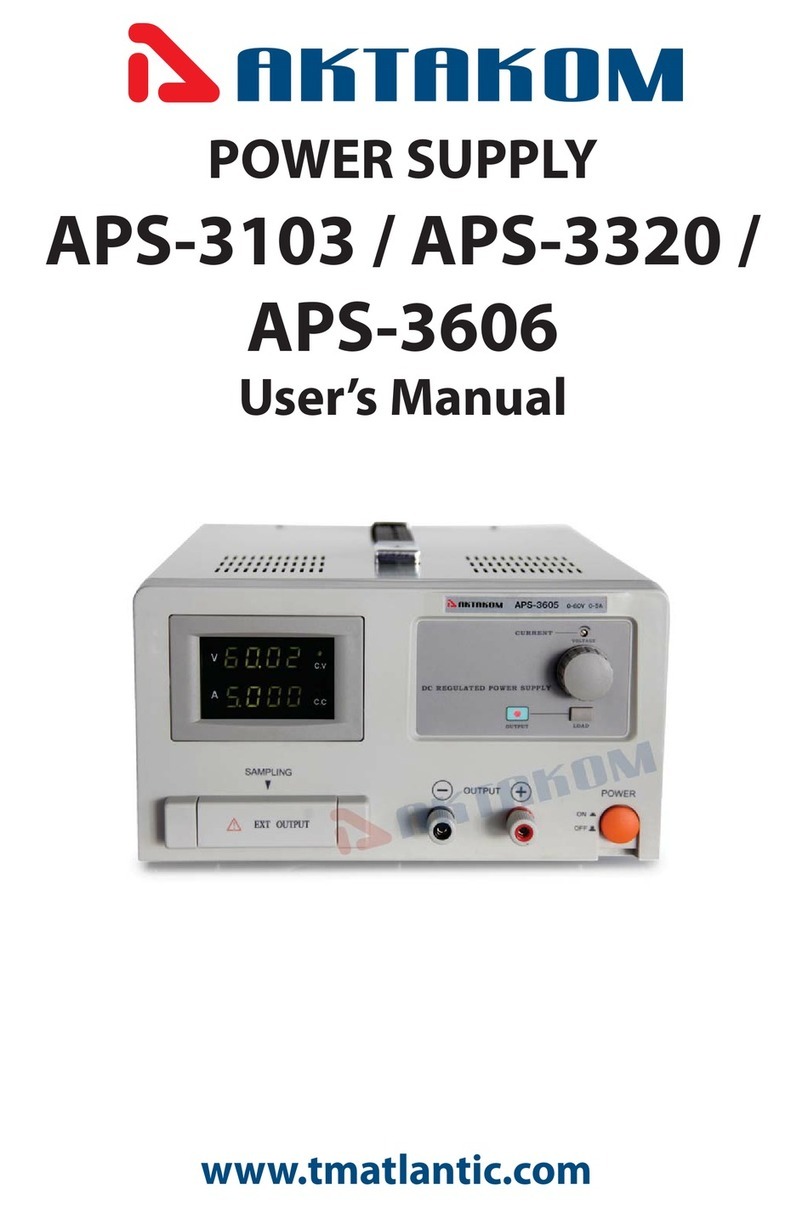
Aktakom
Aktakom APS-3103 user manual
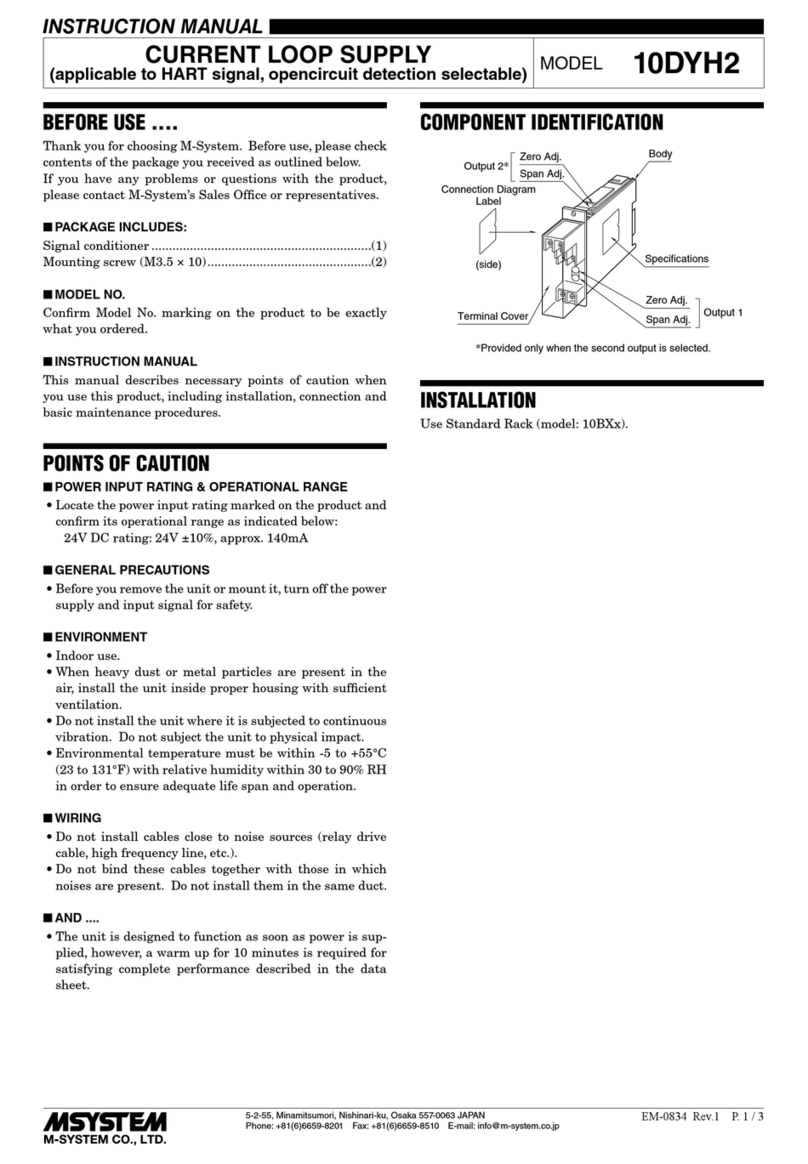
M-system
M-system 10DYH2 instruction manual
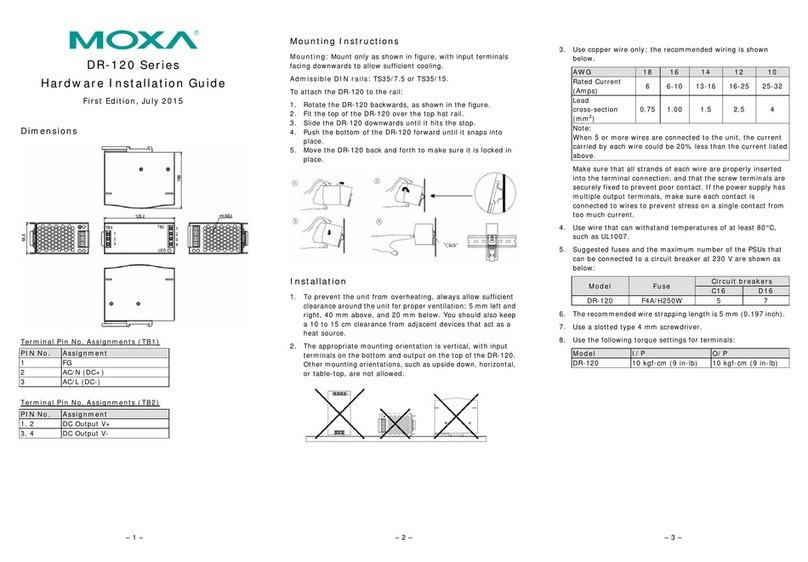
Moxa Technologies
Moxa Technologies DR-120 Series Hardware installation guide
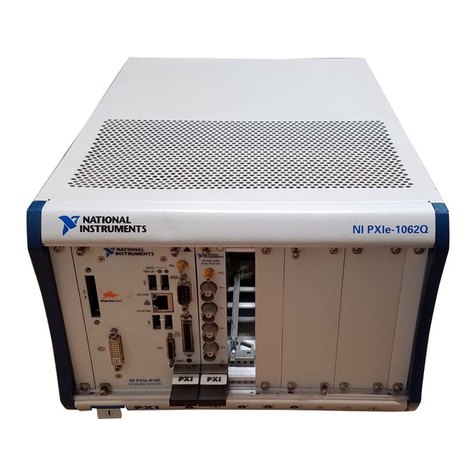
National Instruments
National Instruments NI PXIe-1062Q user guide

Altronix
Altronix SMP5PM quick start guide
